Marc Chagall
> Art and life
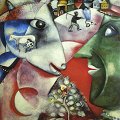 Marc Chagall (1887-1985) has experienced a
strange fate in his former homeland of Russia.
Yet it was to Russia that Chagall turned in days of joy and sorrow.
Symbolising his former homeland, the snow-covered houses and Orthodox
churches of Vitebsk were a permanent feature of his paintings and
engravings - right up to the very end. It was in Vitebsk and St. Petersburg
that Chagall developed into the master now known and loved throughout the
world. Many of his famous masterpieces were created in Vitebsk, St.
Petersburg and Moscow. The first monograph on the artist was published in
Russia in 1918. This was followed by a long period of silence and unfair
criticism of the master in the Soviet Union.
Marc Chagall (1887-1985) has experienced a
strange fate in his former homeland of Russia.
Yet it was to Russia that Chagall turned in days of joy and sorrow.
Symbolising his former homeland, the snow-covered houses and Orthodox
churches of Vitebsk were a permanent feature of his paintings and
engravings - right up to the very end. It was in Vitebsk and St. Petersburg
that Chagall developed into the master now known and loved throughout the
world. Many of his famous masterpieces were created in Vitebsk, St.
Petersburg and Moscow. The first monograph on the artist was published in
Russia in 1918. This was followed by a long period of silence and unfair
criticism of the master in the Soviet Union.
Marc Chagall enjoyed a long and creative life, filled with exciting aesthetic discoveries. He outlived all his contemporaries - the pioneers of the Russian avant-garde - avoiding their professional failures and persecutions. Chagall now ranks alongside such other leading Parisian artists as Matisse, Picasso and Fernand Leger as a leading reformer who made a major contribution to the artistic vision of mankind. The master's works are the flesh and blood of the twentieth century - a mixture of bright spiritual and scholarly ascents and dark descents into the tragedy of war and genocide. The cultural and social environment of Russia in the first quarter of the twentieth century was an important element in the formation of his rich oeuvre and artistic consciousness. Chagall was much younger than the artists of the Blue Rose group, Mikhail Larionov, Natalia Goncharova and the majority of members of the Jack of Diamonds. He began his career when the younger generation of Russian artists was rediscovering the Russian provinces, inspired by the bold experiments of Gauguin, Cezanne and Van Gogh. They attempted to break away from the tyranny of the "schools and academies", seeking free self-expression in art. Drawn to the spiritual vigour of a world untouched by the sores of modern civilisation and the beauty and exoticism of provincial art, they were inspired by the simple expressiveness of lubok prints, wooden and clay toys, painted trays and traditional shop signboards.
Russia & Belarus
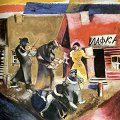 Chagall grew up in this environment, not knowing anything else until
the age of nineteen. This was the setting for his childhood games,
adolescence, first loves, first poems and gradual realisation of his
natural talent for art. Life in the poor Jewish districts of Vitebsk
consisted of an annual cycle of religious holidays, strict observation of
the Hassidic rites and the constant threat of pogroms. The atmosphere of
official prohibitions and permanent sense of injustice in the Pale of
Settlement developed a will to live and an aspiration towards higher
ideals.
Chagall grew up in this environment, not knowing anything else until
the age of nineteen. This was the setting for his childhood games,
adolescence, first loves, first poems and gradual realisation of his
natural talent for art. Life in the poor Jewish districts of Vitebsk
consisted of an annual cycle of religious holidays, strict observation of
the Hassidic rites and the constant threat of pogroms. The atmosphere of
official prohibitions and permanent sense of injustice in the Pale of
Settlement developed a will to live and an aspiration towards higher
ideals.
Chagall's parents - a fishmonger and the owner of a small grocery shop - worked hard to ensure that there was always bread on the table for their nine children. When he was thirteen, they managed to overcome all the impediments and send him to grammar school. He was immediately enrolled in the third grade, where he showed a talent for art - much to the dismay of his parents. After finishing school in 1906, Chagall worked as a photographer's apprentice. For three months, he studied painting and drawing at the studio of Yehuda Pen, a former student of Pavel Chistyakov at the Imperial Academy of Arts. At the end of the year Chagall decided to continue his career in the city and asked his parents for the money to go to St. Petersburg. His parents greeted this decision with dismay and his father threw the coins onto the floor. Marc picked up the money in tears and set out for the capital. After failing the entrance examination for the Baron Stieglitz Central School of Technical Drawing, Chagall managed to enrol in the third grade of the school of drawing at the Imperial Society for the Encouragement of Arts in early 1907. He earned money by giving private lessons and occasionally received remunerations from relatives. As accreditation as a tradesman gave the right to live in the Russian capital, Marc found employment in a signboard workshop. He won a competition at the school of drawing and was awarded an annual scholarship.
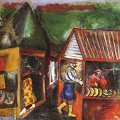 Infected by the growing demand for change in art, Chagall soon grew
disillusioned with the teaching methods at the Imperial Society for the
Encouragement of Arts and left the school of drawing. Such students of the
Moscow School of Painting, Sculpture and Architecture as Aristarkh
Lentulov, the Burliuk brothers, Mikhail Larionov and Natalia Goncharova
had already began their audacious Neo-Primitive experiments. After
attending the studio of Savely Seidenberg, Chagall transferred to the
Elizaveta Zvantseva School of Art, located in the same building as Russian
Symbolist poet Vyacheslav Ivanov's famous "Tower".
Infected by the growing demand for change in art, Chagall soon grew
disillusioned with the teaching methods at the Imperial Society for the
Encouragement of Arts and left the school of drawing. Such students of the
Moscow School of Painting, Sculpture and Architecture as Aristarkh
Lentulov, the Burliuk brothers, Mikhail Larionov and Natalia Goncharova
had already began their audacious Neo-Primitive experiments. After
attending the studio of Savely Seidenberg, Chagall transferred to the
Elizaveta Zvantseva School of Art, located in the same building as Russian
Symbolist poet Vyacheslav Ivanov's famous "Tower".
Chagall's teachers at the Elizaveta Zvantseva School of Art were Leon Bakst and Mstislav Dobuzhinsky. After visiting Greece in 1907, Bakst developed the idea of a synthesis of arts and choral action. He dreamt of reviving the monumental art of the part and creating a school of fresco painters. His teaching methods combined quests for a grand form with the latest experiments in colourism. Like his fellow students, Chagall painted colourful studies of close-up figures on bright backgrounds. He was regarded as the most talented colourist at the Elizaveta Zvantseva School of Art. The young master avidly worked in different styles, influenced by the many exhibitions held by the pioneers of the avant-garde in St Petersburg between 1908 and 1910.
 Chagall's student works show that he was a proficient draughtsman,
exploring the possibilities of Art Nouveau and its inspired, decorative
forms. Unlike the other students, who rejected narrative in art, he
enjoyed painting expressive details and arranging the composition in an
orderly manner Holy Family (1909) depicts a falling out in a family of
intellectuals. The characters are estranged from one another by the cosmic
situation and the light deformation of the interior Other student works
are refined colour harmonies, based on hidden metaphors and akin to
Symbolist poetry. Ring (1908-09) reflects the intellectual atmosphere of
life in St. Petersburg. Distorting the natural forms and employing rich and
suggestive tones, the artist created sharp and expressive images in his
landscapes and interiors of this period. Corpse (Death) (1908) combines
open poetry with deformation, a tense colour scheme and such illogical
details and situations as a fiddler on a roof. Painted a year after the
first Neo-Primitive works of Mikhail Larionov, Corpse (Death) contains the
germ of Chagall's future formula. The painting intertwines elements of
life in the Jewish heartland of the Russian Empire, orthodox religious
views, folklore traditions and Russian Symbolism. Chagall's work also
reflects the complex and contradictory quests of a young artist loathe to
part with the traditional skills of academic drawing. In spring 1910, he
contributed Corpse (Death) to his first exhibition - a show of the works
of the students of the Elizaveta Zvantseva School of Art at the editorial
offices of Apollo in St. Petersburg.
Chagall's student works show that he was a proficient draughtsman,
exploring the possibilities of Art Nouveau and its inspired, decorative
forms. Unlike the other students, who rejected narrative in art, he
enjoyed painting expressive details and arranging the composition in an
orderly manner Holy Family (1909) depicts a falling out in a family of
intellectuals. The characters are estranged from one another by the cosmic
situation and the light deformation of the interior Other student works
are refined colour harmonies, based on hidden metaphors and akin to
Symbolist poetry. Ring (1908-09) reflects the intellectual atmosphere of
life in St. Petersburg. Distorting the natural forms and employing rich and
suggestive tones, the artist created sharp and expressive images in his
landscapes and interiors of this period. Corpse (Death) (1908) combines
open poetry with deformation, a tense colour scheme and such illogical
details and situations as a fiddler on a roof. Painted a year after the
first Neo-Primitive works of Mikhail Larionov, Corpse (Death) contains the
germ of Chagall's future formula. The painting intertwines elements of
life in the Jewish heartland of the Russian Empire, orthodox religious
views, folklore traditions and Russian Symbolism. Chagall's work also
reflects the complex and contradictory quests of a young artist loathe to
part with the traditional skills of academic drawing. In spring 1910, he
contributed Corpse (Death) to his first exhibition - a show of the works
of the students of the Elizaveta Zvantseva School of Art at the editorial
offices of Apollo in St. Petersburg.
In 1909, Chagall was introduced to Maxim Vinaver, a Duma deputy and editor of Ascent, a liberal Jewish art magazine. He held a one-man show of the artist's works at his own editorial office and paid for a trip to France. Marc left for Paris in August 1910, following a long line of Russians, Poles, Scandinavians and talented young Jews from Eastern Europe flocking to the international capital of art in those years.
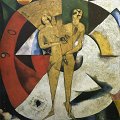 The second half of the 1900s witnessed a growth of national
self-consciousness among the Jews of the Russian Empire. Attempting to
overcome the official restrictions confining them to the Pale of
Settlement, they also re-examined the traditional views of Judaism on
figurative art, rejecting the prohibitions on the representation of man.
In Paris, Marc Chagall studied at the Academie de la Grand Chaumiere and
the Academie de la Palette and visited the museums and exhibitions. His
first independent works reflect the great diversity of his artistic
interests - life studies of Paris and the Eiffel Tower, still-lifes
transformed by his poetic fantasy and exotic images of Russian coachmen or
girls carrying buckets on yokes.
The second half of the 1900s witnessed a growth of national
self-consciousness among the Jews of the Russian Empire. Attempting to
overcome the official restrictions confining them to the Pale of
Settlement, they also re-examined the traditional views of Judaism on
figurative art, rejecting the prohibitions on the representation of man.
In Paris, Marc Chagall studied at the Academie de la Grand Chaumiere and
the Academie de la Palette and visited the museums and exhibitions. His
first independent works reflect the great diversity of his artistic
interests - life studies of Paris and the Eiffel Tower, still-lifes
transformed by his poetic fantasy and exotic images of Russian coachmen or
girls carrying buckets on yokes.
Genre scenes of life in Vitebsk and Liozno were more representative of Chagall's future oeuvre. In Butcher (1910), the flattened and simplified forms and sense of the estrangement of reality transform a modest scene of everyday life into an important ritual. With its sharp forms, jumbled scale and perspective and vivid representation of the types and customs of the Pale of Settlement, Wedding (1910) was an important step on the road to Chagall's future formula. The artist studied the works of the Fauvists, about which he had heard so much in St. Petersburg, admiring their free and unfettered colours and suggestive and emotional tones. These features interact in his own works with memories of Russian icons, creating an explosive cocktail in Self-Portrait with a Halo (1911). In 1911, Chagall experienced a period of interest in Cubism, reproducing its analytical structures and ascetic tones in a number of portraits, genre scenes and nudes - Nude with Coiffure (1911). Cubism offered the artist the chance to freely interpret the motifs of reality, play with form and space and express his own metaphorical line of thinking.
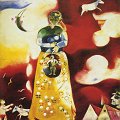 Rain (1911) and To Russia, Donkeys and Others (1911) are excellent
examples of the formation of Chagall's stylistics. People and animals live
in fraternal unity, belonging both to the earth and the cosmos. There is
no sense of gravity; they are equally at home on the rooftops of houses or
moving freely about the sky. The heads of people caught up in their
everyday concerns also appear. These motifs later became permanent
features of Chagall's oeuvre, bringing together the artist's own fertile
imagination and poetic personality, the way of life of the provinces,
Jewish and Russian folklore, Symbolist impressions of St. Petersburg and
the structural theories of Cubism.
Rain (1911) and To Russia, Donkeys and Others (1911) are excellent
examples of the formation of Chagall's stylistics. People and animals live
in fraternal unity, belonging both to the earth and the cosmos. There is
no sense of gravity; they are equally at home on the rooftops of houses or
moving freely about the sky. The heads of people caught up in their
everyday concerns also appear. These motifs later became permanent
features of Chagall's oeuvre, bringing together the artist's own fertile
imagination and poetic personality, the way of life of the provinces,
Jewish and Russian folklore, Symbolist impressions of St. Petersburg and
the structural theories of Cubism.
In 1911, Marc Chagall rented a studio at La Ruche in Montparnasse, joining the colony of foreign artists who later became known as the Ecole de Paris. He associated with painters Jean Metzingen Robert Delaunay, Fernand Leger and Modigliani, sculptors Jacques Lipchitz, Henri Laurens and Alexandre Archipenko and poets Guillaume Apollinaire and Blaise Cendrars. They encouraged his artistic quests, helping him to emerge as the leading master of the School of Paris.
In 1912, Chagall contributed to the annual exhibitions of the Salon des Independants and the Salon d'Automne and foreign shows of modern art. He also sent pictures to exhibitions in Russia, contributing Corpse (Death) to Mikhail Larionov Donkey's Tail in Moscow in 1912.
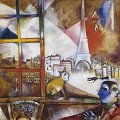 In 1913, Chagall was invited to participate in Die erste deutsche
Herbstsalon, held at the Galerie der Sturm in Berlin. The German public
highly rated the Expressionist nature of his fantastic genre scenes. In
May 1914, he held his first one-man show at the Galerie der Sturm. He made
a brief trip to Vitebsk in the summer of 1914, when the First World War
broke out, ruining his plans to return to Berlin. Although only a small
period in the artist's long and prolific careen the years spent in Russia
from 1914 to 1922 were extremely rich and productive in terms of
creativity and the master's professional establishment. Living through two
wars and two revolutions, Chagall worked as an artist and occupied various
administrative posts as commissar for art in Vitebsk Province and founder,
director and teacher of the Vitebsk School of Art He designed panels and
mosaics, theatrical sets and costumes and street decorations on Communist
holidays.
In 1913, Chagall was invited to participate in Die erste deutsche
Herbstsalon, held at the Galerie der Sturm in Berlin. The German public
highly rated the Expressionist nature of his fantastic genre scenes. In
May 1914, he held his first one-man show at the Galerie der Sturm. He made
a brief trip to Vitebsk in the summer of 1914, when the First World War
broke out, ruining his plans to return to Berlin. Although only a small
period in the artist's long and prolific careen the years spent in Russia
from 1914 to 1922 were extremely rich and productive in terms of
creativity and the master's professional establishment. Living through two
wars and two revolutions, Chagall worked as an artist and occupied various
administrative posts as commissar for art in Vitebsk Province and founder,
director and teacher of the Vitebsk School of Art He designed panels and
mosaics, theatrical sets and costumes and street decorations on Communist
holidays.
Chagall's art was directly influenced by political events in Russia. In the first months of the First World War, he produced many black-and-white drawings - tragic and expressive images of the first victims of the war (soldiers and refugees) and views of his native town caught up in the maelstrom - Injured Soldier (1914), Group of People (1914-15) and Lamentation (1914-15). In Newspaper Seller (1914), the weary postman on the scarlet background is interpreted as an inexorable herald of bad tidings. The avant-garde and Symbolist images in Clock (1914) and Mirror (1915) reflect the tension of the First World Wan when human happiness was particularly fragile and the direction of a piece of lead or shrapnel decided the question of life or death. Chagall continued to paint colourful images of Jewish priests and elders. Red Jew (1915) portrays a preacher from Slucak, full of faith and detached from worldly passions. The artist's interest in Hebrew traditions and affection for the past can be sensed in Jewish Cemetery Gates (1917) and Cemetery (1917). The very stones seem to cry out in these dramatic canvases enriched with elements of Cubism.
World War I
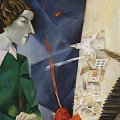 The First World War increased Chagall's interest in reality and
working from life. Vitebsk is depicted in a complex combination of
different techniques and media - a conglomeration of old buildings in the
historical center and the motley houses and rickety fences of the
outskirts. Such townscapes as Vitebsk (1914) and View from a Window,
Vitebsk (1914) contain much poetry and sorrow. In 1914 and 1915, Chagall
painted a series of warm and touchingly simple portraits of the members of
his family - Father (1914), Barber Shop (1914) and Maryasenka (1914-15).
His artistic vision was enriched by his happy married life with Bella
Rosenfeld. They married in July 1917 and lived at a dacha in Zaolsha,
where the thin birch trees evoked a sharp feeling of tenderness and a sense
of the fragility of the beautiful - Window at a Dacha (1915). The artist
also addressed the quiet poetry of family life and interiors in Lilies of
the Valley (1916), Bathing a Child (1916) and Window into a Garden
(1917).
The First World War increased Chagall's interest in reality and
working from life. Vitebsk is depicted in a complex combination of
different techniques and media - a conglomeration of old buildings in the
historical center and the motley houses and rickety fences of the
outskirts. Such townscapes as Vitebsk (1914) and View from a Window,
Vitebsk (1914) contain much poetry and sorrow. In 1914 and 1915, Chagall
painted a series of warm and touchingly simple portraits of the members of
his family - Father (1914), Barber Shop (1914) and Maryasenka (1914-15).
His artistic vision was enriched by his happy married life with Bella
Rosenfeld. They married in July 1917 and lived at a dacha in Zaolsha,
where the thin birch trees evoked a sharp feeling of tenderness and a sense
of the fragility of the beautiful - Window at a Dacha (1915). The artist
also addressed the quiet poetry of family life and interiors in Lilies of
the Valley (1916), Bathing a Child (1916) and Window into a Garden
(1917).
In his images of lovers, Chagall addresses a task unusual for Russian painting at that time. He attempts to convey the feeling of love with the help of colour in Blue Lovers (1914) and Green Lovers (1916-17), varying the combinations of tones, altering the compositions and activating the role of the texture and thickness of the brush-strokes. The artist pays tribute to his muse in Bella with a White Collar (191 7).The subject is majestic and inaccessible as a dream in this whimsical combination of Neoclassicism and Cubism. Chagall conveyed his feelings for Bella in a series of large and poetic canvases - Promenade (1917), Over a Town (1914-18), Double Portrait with a Glass of Wine (1917-18) and Wedding Ceremony (1918). Although blessed by an angel or floating above Vitebsk, the couple are not carefree or overwhelmed with happiness. From their vantage points, they seem to have already spotted the trials and tribulations awaiting them in the future.
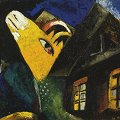 These works represent the first occasions when Chagall sent concrete
people into free flight. Retaining portrait likenesses, the artist
skillfully employs form, colour and the composition to achieve the effect
of weightlessness and the sense of floating in the air Chagall often
addressed the self-portrait when resolving important creative tasks.
Self-Portrait with a Palette (1914) is austere and analytical, while
Self-Portrait in Green (1914) is light and poetic. One of the greatest
works of Chagall's Russian period is Vision. Self-Portrait with Muse
(1917-18), with the baroque splendour of its cubic forms and handsome,
ascetic tones. The painting addresses a theme that occupied the master
throughout his career - the question of creative inspiration and the
service of art. In 1920, Chagall was invited to paint a series of panels
for the auditorium of the Jewish Chamber Theatre in Moscow. He coped
admirably with this difficult new task, skillfully combining elements of
monumentality, decorativeness and bright imagery. The audacious and
captivating Introduction to the Jewish Theatre draws parallels between
this Hebrew folk phenomenon and the Italian comedy of masks, masterly
combining the artist's own individual stylistics with elements of
Constructivism.
These works represent the first occasions when Chagall sent concrete
people into free flight. Retaining portrait likenesses, the artist
skillfully employs form, colour and the composition to achieve the effect
of weightlessness and the sense of floating in the air Chagall often
addressed the self-portrait when resolving important creative tasks.
Self-Portrait with a Palette (1914) is austere and analytical, while
Self-Portrait in Green (1914) is light and poetic. One of the greatest
works of Chagall's Russian period is Vision. Self-Portrait with Muse
(1917-18), with the baroque splendour of its cubic forms and handsome,
ascetic tones. The painting addresses a theme that occupied the master
throughout his career - the question of creative inspiration and the
service of art. In 1920, Chagall was invited to paint a series of panels
for the auditorium of the Jewish Chamber Theatre in Moscow. He coped
admirably with this difficult new task, skillfully combining elements of
monumentality, decorativeness and bright imagery. The audacious and
captivating Introduction to the Jewish Theatre draws parallels between
this Hebrew folk phenomenon and the Italian comedy of masks, masterly
combining the artist's own individual stylistics with elements of
Constructivism.
France
Chagall left Russia forever in the summer of 1922. In Moscow, he heard that his one-man show at the Galerie der Sturm in 1914 had played an important role in the history of German Expressionism. He decided to return to Germany and track down the works that he had left in Berlin when the First World War broke out. He found that the paintings had been sold and the proceeds wiped out by hyperinflation. Undaunted, Chagall set about planning a new exhibition of his latest Russian works. He finished writing Ma vie and received an offer from Paul Cassirer, who wanted to publish the book with illustrations engraved by the author Chagall took up etching and Ma vie was published in 1923.The artist moved to France, where he spent the rest of his life.
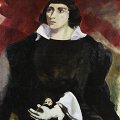 Chagall's etchings were so successful that famous French art dealer and
publisher Ambroise Vollard asked him to illustrate Nikolai Gogol's Dead
Souls, Jean de la Fontaine's Fables and the Bible. While this new interest
in engraving was an important influence on the figurative structure of the
master's works, he still continued to enjoy his greatest success in
painting.
Chagall's etchings were so successful that famous French art dealer and
publisher Ambroise Vollard asked him to illustrate Nikolai Gogol's Dead
Souls, Jean de la Fontaine's Fables and the Bible. While this new interest
in engraving was an important influence on the figurative structure of the
master's works, he still continued to enjoy his greatest success in
painting.
The associative and metaphorical foundations of Chagall's refined and intellectual art acquired their final form in the 1920s and 1930s. Based on traditional folklore, everyday life and religious mysticism, his poetic and fantastic paintings represented a unique fusion of the ideas of Symbolism and the devices of Fauvism, Cubism and Expressionism. The master created his own individual mythology and figurative mixture of the earth and cosmos, Paris and provincial Russia, angels, people and animals, co-existing in equilibrium and undergoing metamorphoses. A fascinating combination of the archaic and the ultra-modern, he belonged to no one country, school or movement.
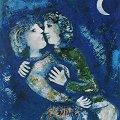 Unlike the preceding Russian period, Chagall virtually abandoned
portraiture in France.The only exception was Bella and their young
daughter Ida. Tender, romantic and monumental, Bella with a Carnation
(1924) offers a fascinating insight into the artist's talent for
portraiture. Throughout the 1920s and 1930s, Chagall painted flowers,
fantasies on the theme of Paris and Vitebsk and motifs of lovers - Bride
with Double Face (1927), Nude over Vitebsk (1933) and Groom and Bride of
the Eiffel Tower (1939). Subtly conveying the heart-stopping emotions of
love, Midsummer Night's Dream (1939) is a rare example of a subject from
classical literature in the master's art. Angel with a Palette (1927-36)
reflects a theme that constantly preoccupied Chagall - the role of the
artist. In this work, Bella is depicted as the patroness of painters.
Unlike the preceding Russian period, Chagall virtually abandoned
portraiture in France.The only exception was Bella and their young
daughter Ida. Tender, romantic and monumental, Bella with a Carnation
(1924) offers a fascinating insight into the artist's talent for
portraiture. Throughout the 1920s and 1930s, Chagall painted flowers,
fantasies on the theme of Paris and Vitebsk and motifs of lovers - Bride
with Double Face (1927), Nude over Vitebsk (1933) and Groom and Bride of
the Eiffel Tower (1939). Subtly conveying the heart-stopping emotions of
love, Midsummer Night's Dream (1939) is a rare example of a subject from
classical literature in the master's art. Angel with a Palette (1927-36)
reflects a theme that constantly preoccupied Chagall - the role of the
artist. In this work, Bella is depicted as the patroness of painters.
In 1927, Ambroise Vollard commissioned nineteen gouaches on the circus theme, introducing a new motif into Chagall's oeuvre in such works as Acrobat (1930). The artist also illustrated the Bible in 1931. In the late 1930s, he painted works on Gospel subjects and a series of compositions on the Crucifixion. Chagall's gouache biblical illustrations played an important role in his personal and professional formation. Vollard believed that the master's creative style best corresponded to the majestic simplicity and essence of the holy scripture. The biblical compositions demanded an especially laconic, lapidary and simple figurative style, which in turn influenced Chagall's own oeuvre. Before beginning work, he visited Palestine, Egypt and Syria, leading to the expressive painting Wailing Wall (1931).
 After the Nazis came to power in Germany in 1933, Chagall's works were
publicly burnt in Mannheim, Munich and Vienna. The growing tension in
pre-war Europe was directly reflected in his outwardly abstracted art. On
the eve of the Second World War, the master painted Revolution (1937) and
the Resistance, Resurrection and Liberation triptych (1937-38).
After the Nazis came to power in Germany in 1933, Chagall's works were
publicly burnt in Mannheim, Munich and Vienna. The growing tension in
pre-war Europe was directly reflected in his outwardly abstracted art. On
the eve of the Second World War, the master painted Revolution (1937) and
the Resistance, Resurrection and Liberation triptych (1937-38).
Reflecting the experiences and feelings of an artist who had experienced war and revolution in Russia, these paintings were intended as a warning. Besides such traditional motifs as brides, musicians and animals with suffering human eyes, the gloomy figurative structure of the triptych also incorporated images of the Crucifixion, rabbis with the Torah, an animal running with a burning candle and demonstrations with red flags. Revolution included a figure of Vladimir Lenin standing on one hand.
United States
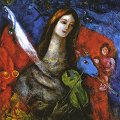 After the Germans occupied France in 1940, the Museum of Modern Art
offered famous French artists political asylum in the United States.
Chagall moved to New York in 1941.The drama of the Second World War was
aggravated by the illness and death of his wife Bella. After a period of
depression, Chagall threw himself back into his work, painting pictures
and designing sets and costumes for classical Russian ballets. There was no
limit to the master's fantasy, adding new contexts of meaning to his
favorite motifs of winged clocks, lovers, and animals holding candles,
fiddlers and acrobats. Several canvases begun before the war - Red Horse
(1938-44) and To my Wife (1938-44) - were finished in New York. Depicting
a burning peasant hut, an Orthodox church on a hill and a gigantic crucifix
lying on the ground, Hallucination (1943) was a direct response to the
events of the Second World War. The motifs of Russian winter landscapes
frequently occur in Chagall's paintings during this period. Harlequins
(1944) can be regarded as a form of greeting to his distant homeland. The
artist portrays a group of travelling actors against snow-covered hovels
and his parent's house and signboard. This image repeats, with minor
changes, the central section of Introduction to the Jewish Theatre.
Chagall's American period ended in 1947, when he returned to France. There
was a growing interest in his art throughout the world in the late 1940s
and 1950s, with retrospectives and one-man shows in Europe and the United
States. Chagall won first prize for graphic art at the Venice Biennale in
1948 and the Erasmus Prize in Copenhagen in 1960. A Chagall House opened
in Haifa in 1957. In 1959, the artist was awarded an honorary degree at
Glasgow University and elected an honorary member of the American Academy
of Arts and Letters.
After the Germans occupied France in 1940, the Museum of Modern Art
offered famous French artists political asylum in the United States.
Chagall moved to New York in 1941.The drama of the Second World War was
aggravated by the illness and death of his wife Bella. After a period of
depression, Chagall threw himself back into his work, painting pictures
and designing sets and costumes for classical Russian ballets. There was no
limit to the master's fantasy, adding new contexts of meaning to his
favorite motifs of winged clocks, lovers, and animals holding candles,
fiddlers and acrobats. Several canvases begun before the war - Red Horse
(1938-44) and To my Wife (1938-44) - were finished in New York. Depicting
a burning peasant hut, an Orthodox church on a hill and a gigantic crucifix
lying on the ground, Hallucination (1943) was a direct response to the
events of the Second World War. The motifs of Russian winter landscapes
frequently occur in Chagall's paintings during this period. Harlequins
(1944) can be regarded as a form of greeting to his distant homeland. The
artist portrays a group of travelling actors against snow-covered hovels
and his parent's house and signboard. This image repeats, with minor
changes, the central section of Introduction to the Jewish Theatre.
Chagall's American period ended in 1947, when he returned to France. There
was a growing interest in his art throughout the world in the late 1940s
and 1950s, with retrospectives and one-man shows in Europe and the United
States. Chagall won first prize for graphic art at the Venice Biennale in
1948 and the Erasmus Prize in Copenhagen in 1960. A Chagall House opened
in Haifa in 1957. In 1959, the artist was awarded an honorary degree at
Glasgow University and elected an honorary member of the American Academy
of Arts and Letters.
While Europe rebuilt itself following six years of wan forming new human and cultural ties, Chagall established himself as a leading master of post-war art. Enriched with new themes, ideas and techniques, his oeuvre became particularly multi-faceted. He addressed such new forms of art as coloured lithography in the 1940s and ceramics and sculpture in the 1950s. Besides painting in oil, he also worked much in gouache.
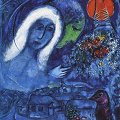 Chagall increasingly worked in monumental painting, possibly after
seeing the frescoes of Diego Rivera and Jose Clemente Orozco in America.
He designed murals for the foyer of the Watergate Theatre in London in 1949
and ceramic panels and stained-glass windows for a baptistery at Assy in
Savoy in 1957. Two of his finest creations in those years were his
stained-glass windows for the Cathedral Saint-Etienne de Metz in 1958 and
the synagogue at the Hadassah Medical Centre in Jerusalem University in
1960. The theme of the latter project was the twelve tribes of Israel.
Chagall's biblical works were heavily influenced by the tragedy of the
Second World War and the realities of post-war Europe.
Chagall increasingly worked in monumental painting, possibly after
seeing the frescoes of Diego Rivera and Jose Clemente Orozco in America.
He designed murals for the foyer of the Watergate Theatre in London in 1949
and ceramic panels and stained-glass windows for a baptistery at Assy in
Savoy in 1957. Two of his finest creations in those years were his
stained-glass windows for the Cathedral Saint-Etienne de Metz in 1958 and
the synagogue at the Hadassah Medical Centre in Jerusalem University in
1960. The theme of the latter project was the twelve tribes of Israel.
Chagall's biblical works were heavily influenced by the tragedy of the
Second World War and the realities of post-war Europe.
In the 1950s, he etched another series of illustrations to the Bible. The biblical themes and images are original, poetic and spiritual in such easel paintings as King David (1951) and Crossing the Red Sea (1955). Naturally inserted in the structure of the image, the motif of the Crucifixion plays an important emotional role in these works. Chagall combines, clashes and transforms high fiction and real, expressive details, the sublime and the mundane, the near and the far and various times in his fantastic simultaneous compositions. A typical feature of the artist's oeuvre - self-portraiture - is particularly prominent in these works. Even in biblical scenes, he often depicts himself at ease or with his wife, on a backdrop of the Vitebsk outskirts seen from space.
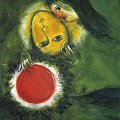 Tinged with features of mysticism, Flayed Ox (1947) expresses Chagall's
thoughts on modernity. Although outwardly similar to a paraphrase of the
art of Chaim Soutine, there are no elements of physiology or nervousness
in this picture. The surreal details create an even stronger impression, as
this work was painted by someone who had experienced the tragedy of war
and looked into the abyss of despair. Reflections on sacrifice and victims
could never be abstract for Marc Chagall.
Tinged with features of mysticism, Flayed Ox (1947) expresses Chagall's
thoughts on modernity. Although outwardly similar to a paraphrase of the
art of Chaim Soutine, there are no elements of physiology or nervousness
in this picture. The surreal details create an even stronger impression, as
this work was painted by someone who had experienced the tragedy of war
and looked into the abyss of despair. Reflections on sacrifice and victims
could never be abstract for Marc Chagall.
Tragedy was not the only theme in Chagall's post-war works. He addressed the enigmatic and melancholy motif of clocks - hovering above the head of the artist frozen at the easel in Self-Portrait with Grandfather Clock. Before the Crucifixion (1947) or hanging above a snow-covered Russian town in Clock with Blue Wing (1949). The images of lovers, circus, his second wife Vava or an imaginary reunion with his relatives in Russia are light and poetic in Appearance of the Artist's Family (1935-47) and Hello, Homeland! (1953). In the 1950s, Chagall worked on a cycle of paintings entitled Fantastic Paris and the Circus series of coloured lithographs. He illustrated such diverse books on love as Longus' Daphnis and Chloe, Giovanni Boccaccio's The Decameron and Paul Eluard's Le dur desir de Durer. Chagall firmly established his place in the history of art in the 1960s and 1970s. The master's eightieth and ninetieth birthdays were marked by a series of major exhibitions and retrospectives. Chagall was awarded honorary degrees from many universities and elected an honorary citizen of Jerusalem in 1977. The Musee national Message Biblique Marc Chagall opened in Nice in 1973. In 1977, he was awarded the Legion d'honneur.
1960s
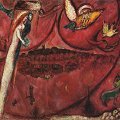 Chagall was as prolific as ever in the 1960s, painting the Commedia
dell'arte mural for a theatre foyer in Frankfurt-On-Main in 1963, a
plafond for the Opera National de Paris in 1964 and two murals for the new
Metropolitan Opera building at the Lincoln Center in New York in 1965. He
designed stained-glass windows and a mosaic for the United Nations
building in 1964 and mosaics, twelve panels and three large gobelins for
the new Israeli parliament building (Knesset) in Jerusalem in 1966.
Throughout the 1970s, he designed stained-glass windows for churches and
public buildings in France, Germany, Switzerland, Britain and the United
States. The biblical theme continued to occupy an important place in
Chagall's easel art. He illustrated the Psalms of David (1978) and painted
such powerful and monumental compositions as Jeremiah (1968), Isaiah
(1968) and Foster (1968).
Chagall was as prolific as ever in the 1960s, painting the Commedia
dell'arte mural for a theatre foyer in Frankfurt-On-Main in 1963, a
plafond for the Opera National de Paris in 1964 and two murals for the new
Metropolitan Opera building at the Lincoln Center in New York in 1965. He
designed stained-glass windows and a mosaic for the United Nations
building in 1964 and mosaics, twelve panels and three large gobelins for
the new Israeli parliament building (Knesset) in Jerusalem in 1966.
Throughout the 1970s, he designed stained-glass windows for churches and
public buildings in France, Germany, Switzerland, Britain and the United
States. The biblical theme continued to occupy an important place in
Chagall's easel art. He illustrated the Psalms of David (1978) and painted
such powerful and monumental compositions as Jeremiah (1968), Isaiah
(1968) and Foster (1968).
In his images of the Old Testament prophets, Chagall's poetic style and primitive forms increase the sensation of burning faith and the power of the spirit. The artist interprets the story of Abraham's hospitality to three angels disguised as travellers as a genre scene in Trinity (1967). Chagall filled his numerous images of flowers, lovers and the circus with mysterious, indiscernible symbols. Studio in Saint Paul (1967) demonstrates the artist's rich creative potential. Painting in light brushstrokes, the artist freely plays with space, discarding the laws of traditional perspective to depict the space of his soul. Chagall continued to appreciate the luscious tones, matt texture and decorative effects offered by gouache. Capturing fleeting images of the mind, he expressed his reflections on the fate and role of the artist in Artist (1972) and Self-Portrait with Wife (1973). There is a strong element of parable to such canvases as Return of the Prodigal Son (1975-76) and Fall of Icarus (1974-77). The stories of the long-awaited meeting of a father and his son or the disastrous flight of the vain Icarus are depicted against the wooden houses and churches of Vitebsk, whose inhabitants abandon their work and rush out into the streets to discuss these extraordinary events. Painted in soft tones and full of lucid sorrow, Return of the Prodigal Son can be regarded as the testament of an artist looking back over his life. Like many other masters of twentieth-century art, Chagall enjoyed a long and prolific life. He continued to work intensely a year before his death, covering his large canvases with light, transparent paints and rich, thick brushstrokes. The artist painted bouquets of flowers, lovers and circus scenes, revisiting his past and intertwining Vitebsk and Paris, Russia and France, in such works as Memories of an Artist (1981) and Artist over Vitebsk (1982).
Marc Chagall was mourned by the whole world when he died at the age of ninety-seven in St-Paul-de-Vence on 28 March 1985.Two of his last creations were Large Circus (1984) and Newly-Weds against Paris (1984). Painted in soft tones of lilac and light blue, the latter work was a dream-like vision reflecting the cosmos of the master's soul - what he remembered and what he continued to love. The canvas depicts the artist and his wife, an enormous bouquet, the Eiffel Tower on the banks of the moonlit Seine, musicians, a painter at an easel, a horse, cow and cockerel with human eyes and the sun breaking over the houses of Vitebsk.
© 2005 V. K.
Marc Chagall Art
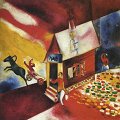
|
|
More
Articles
 Art Encyclopedia A world history of art in articles.
Art Encyclopedia A world history of art in articles.
Modernism
Marc Chagall
Art, life, and symbolic expression.
Biography.
About my art.
Art
 Art Wallpapers Art image collections for your desktop.
Art Wallpapers Art image collections for your desktop.
Munch Art, $19
(75 pictures)
Malevich Art, $25
(105 pictures)
Modigliani Art, $29
(135 pictures)
Klee Art, $25
(150 pictures)
Miro Art, $35
(150 pictures)
Matisse Art, $29
(180 pictures)
Picasso Art, $29
(175 pictures)
Dali Art, $35
(275 pictures)
Chagall Art, $35
(175 pictures)

